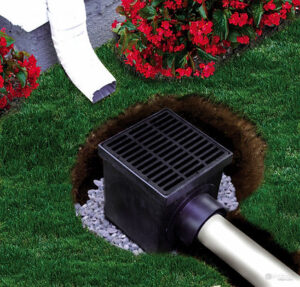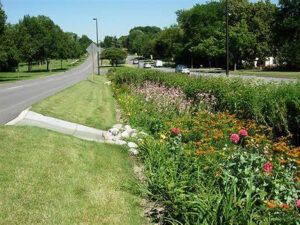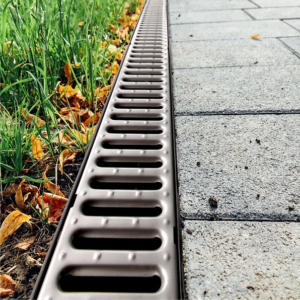Landscaping is not just about aesthetics; it’s also about functionality and sustainability. One important aspect of a well-designed landscape is a drainage system. Proper drainage ensures that water is managed efficiently, preventing erosion, waterlogging, standing water, and keeping water away from your house! Let’s explore some of the different types of drainage systems.
French Drains
 French drains are a popular choice for managing excess water for landscapes in the Western Washington areas. French drains consist of a trench, lined with landscape fabric, then filled with gravel or drain rock and a perforated pipe. Water enters the pipe through the gravel and is then carried away from the area. French drains can be used almost anywhere that there is excess water. French drains are excellent for diverting water from foundations, preventing soil erosion, preventing a soggy lawn, and maintaining the health of your plants.
French drains are a popular choice for managing excess water for landscapes in the Western Washington areas. French drains consist of a trench, lined with landscape fabric, then filled with gravel or drain rock and a perforated pipe. Water enters the pipe through the gravel and is then carried away from the area. French drains can be used almost anywhere that there is excess water. French drains are excellent for diverting water from foundations, preventing soil erosion, preventing a soggy lawn, and maintaining the health of your plants.
Catch basins
 A catch basin is a key component of many landscape drainage systems. It consists of a concrete or plastic structure with a grate or cover on top. Below the grate, there is a collection chamber that connects to an underground pipe network. Catch basins are strategically placed in low-lying or problematic areas where water tends to accumulate such as driveways, parking lots, or areas with poor drainage. The grate on top of the catch basin serves as a filter, preventing large debris like leaves and sticks from entering the system. The chamber on the bottom of the catch basin allows for quick and easy maintenance of your drainage system as by collecting dirt and silt to be removed periodically. Catch basins are an excellent addition to your drainage system and can be used in conjunction with almost all other types of drainage.
A catch basin is a key component of many landscape drainage systems. It consists of a concrete or plastic structure with a grate or cover on top. Below the grate, there is a collection chamber that connects to an underground pipe network. Catch basins are strategically placed in low-lying or problematic areas where water tends to accumulate such as driveways, parking lots, or areas with poor drainage. The grate on top of the catch basin serves as a filter, preventing large debris like leaves and sticks from entering the system. The chamber on the bottom of the catch basin allows for quick and easy maintenance of your drainage system as by collecting dirt and silt to be removed periodically. Catch basins are an excellent addition to your drainage system and can be used in conjunction with almost all other types of drainage.
Dry creek beds
 Dry creek beds mimic the appearance of a natural riverbed without the presence of water. They consist of a shallow trench or depression filled with a combination of rocks, stones, and larger boulders, arranged in a way that resembles the path of a naturally occurring stream. These features offer several advantages for your landscape including erosion control, water management and an aesthetic appeal. They serve as effective barriers that also guide excess water safely away from your property. Dry creek beds are excellent for managing water flow on your property. They can help distribute and disperse water, preventing puddles and standing water in specific areas. Beyond their practical uses, dry creek beds can enhance the visual appeal of your landscape by adding a natural element that complements a variety of landscaping styles.
Dry creek beds mimic the appearance of a natural riverbed without the presence of water. They consist of a shallow trench or depression filled with a combination of rocks, stones, and larger boulders, arranged in a way that resembles the path of a naturally occurring stream. These features offer several advantages for your landscape including erosion control, water management and an aesthetic appeal. They serve as effective barriers that also guide excess water safely away from your property. Dry creek beds are excellent for managing water flow on your property. They can help distribute and disperse water, preventing puddles and standing water in specific areas. Beyond their practical uses, dry creek beds can enhance the visual appeal of your landscape by adding a natural element that complements a variety of landscaping styles.
Dry Wells
 Dry wells, also known as soak pits, are underground pits or chambers designed to collect and disperse excess water underground. They are typically filled with drain rock, cobble or gravel, allowing water to slowly dissipate into the ground. Some dry wells consist of a pre constructed plastic chamber with holes designed to collect and disperse water. Dry wells are used if there isn’t a convenient place for water to be directed and managed. Dry wells consist of a large hole dug into the ground approximately 3’x3’ large. They are lined with landscape fabric on the sides and filled with smaller rock/cobble. The landscape fabric is used on the sides of the hole to keep the soil and rock from mixing. However the fabric should not be placed on the bottom of the hole to allow the water to slowly dissipate into the ground. Dry wells are an excellent way to control and manage water effectively if you live in an area without convenient city drainage and/or has challenging slopes and elevations.
Dry wells, also known as soak pits, are underground pits or chambers designed to collect and disperse excess water underground. They are typically filled with drain rock, cobble or gravel, allowing water to slowly dissipate into the ground. Some dry wells consist of a pre constructed plastic chamber with holes designed to collect and disperse water. Dry wells are used if there isn’t a convenient place for water to be directed and managed. Dry wells consist of a large hole dug into the ground approximately 3’x3’ large. They are lined with landscape fabric on the sides and filled with smaller rock/cobble. The landscape fabric is used on the sides of the hole to keep the soil and rock from mixing. However the fabric should not be placed on the bottom of the hole to allow the water to slowly dissipate into the ground. Dry wells are an excellent way to control and manage water effectively if you live in an area without convenient city drainage and/or has challenging slopes and elevations.
Rain Gardens
 Rain gardens also known as Bioretention areas can be both functional and beautiful. They are shallow depressions back filled with drain rock and sandy soil, then planted with native plants that are capable of absorbing excess water. Rain gardens are strategically located to capture rainwater runoff, filter pollutants, and prevent erosion. They can be a fantastic addition to your landscape, attracting wildlife and adding aesthetic value.
Rain gardens also known as Bioretention areas can be both functional and beautiful. They are shallow depressions back filled with drain rock and sandy soil, then planted with native plants that are capable of absorbing excess water. Rain gardens are strategically located to capture rainwater runoff, filter pollutants, and prevent erosion. They can be a fantastic addition to your landscape, attracting wildlife and adding aesthetic value.
Channel Drains
 Channel drains, also known as trench drains, are linear drainage systems designed to capture and divert surface water in areas with high runoff. These drains consist of a trench with a grated cover that allows water to enter while preventing debris from clogging the system. Channel drains are commonly used in driveways, walkways, and patios.
Channel drains, also known as trench drains, are linear drainage systems designed to capture and divert surface water in areas with high runoff. These drains consist of a trench with a grated cover that allows water to enter while preventing debris from clogging the system. Channel drains are commonly used in driveways, walkways, and patios.
Conclusion
Landscaping drainage systems are essential components of a well-planned and sustainable outdoor space. Choosing the right drainage system for your landscape depends on various factors, including the layout of your property, the climate, and your specific needs. Whether you opt for French drains, dry creek bed, dry wells, rain gardens,, channel drains, or a combination of a few, the goal is the same: efficient water management to protect your landscape and your home. By considering the different types of landscaping drainage systems and their benefits, you can make informed decisions to ensure a healthy and beautiful outdoor environment.

